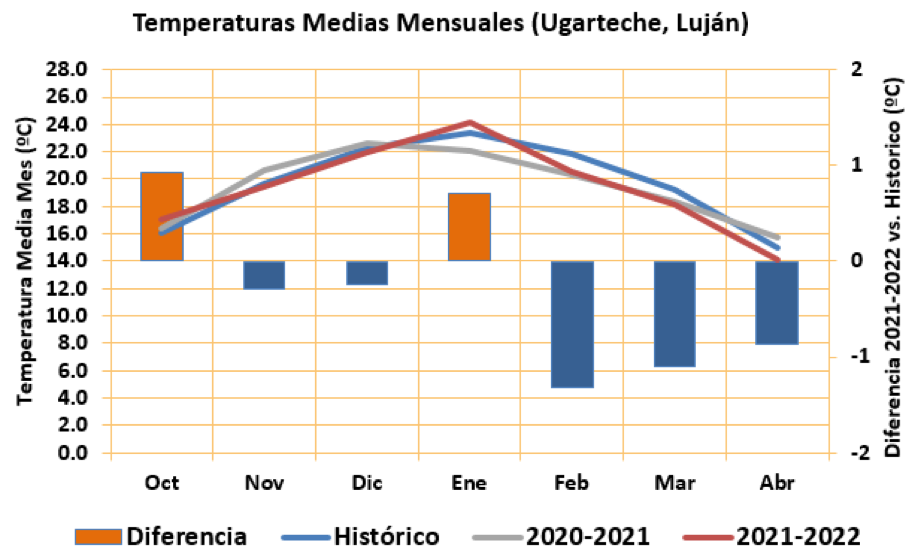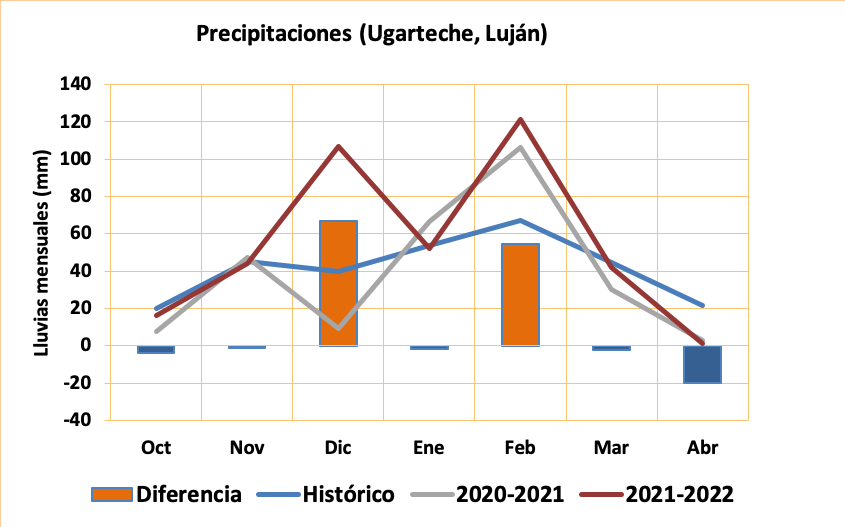2021-2022 season had some weather-related challenges. In particular, the late frosts at the end of September and beginning of October disturbed growth and production in the most exposed vineyards. The season generally presented an average of normal temperatures due to the historical record, with the months of October and January being relatively warm and the rest of the season cooler. Rainfall during the season were above average, mainly concentrated in December and February. This explains why the harvest at provincial level (Mendoza) was a 15% lower than the historical average, and 18% lower at national level, due in part of the attacks of peronospora in clusters that occurred after the December rains. At Doña Paula the vintage was very good in volume and the quality of the wines obtained was also very good to outstanding in the case of the whites and outstanding for all the reds.
Phenology
The season began with a bud break in October 4 for Malbec in Luján de Cuyo, 7 to 10 days later than historical averages, probably due to some frosts at mid-September that delayed the start of the process. For flowering, the cycle began to normalize (November 2) and the same was observed for veraison, which occurred on January 18 for the same variety, a date close to the historical average. The beginning of the harvest for white varieties was quite late, concentrated between the second half of February and the first half of March, on average 10 days later than normal, while the red varieties were harvested on normal dates, so there was a significant overlap between the two.
Temperatures
The following graphic shows that the 2021-2022 season (red line) presented normal temperatures in the spring and cooler in the summer than the historical average (blue line), especially from February onwards. The bars in the graphic show this difference in degrees Celsius. Compared to the 2020-2021 season (gray line), it was somewhat cooler in the spring, warmer only in January. Averaged over the entire growing season (October to April), the 2021-2022 season was 0.2°C cooler than the previous year and 0.3°C lower than the historical average. Given that the greatest differences occurred in the months of grape maturity, we can classify this as a cool season.

Rains
Rainfall recorded during the season (October-April, red line) were above historical averages (384 mm vs 286 mm), as there were two months more rainy than usual (December and February, see bars in the graphic), while the rest of the months were very similar to the historical average. Compared to the previous year (gray lines), this year was pretty similar with the exception of December 2021, which was strikingly wetter than the previous year.

Wines
Luján de Cuyo
Whites: The white wines showed very good varietal typicity in general, although the concentration was average due to February rains, which in some cases created some dilution. In the case of the Chardonnay, we found very good acidity, mineral notes and good body, while Sauvignon Blanc gave wines ranging from herbal to citrus in the earlier vintages, to peach and tropical notes in the later ones, with medium concentration on the palate.
Reds: It was a very good year for the Cabernet Sauvignon from this region, characterized by black and red fruit and species such as paprika and black pepper. The Malbecs stood out for their good color, intense aromas of plump and herbs, and elegant structure on the palate.
Uco Valley
Whites: The white wines from the Uco Valley stood out for their expressive aromas, especially Sauvignon Blanc, with herbal and citrus notes. The structure of the Chardonnay was medium, highlighted by marked acidity.
Reds: The red wines presented an intense color and aromas, where the species and herbs had a leading role compared to other vintages in relation to the fruit. Within the fruit profile we can highlight blackberries and violets in the case of Malbec, which completed the aromatic profile. The concentration of this varietals was generally medium to high. Cabernet Franc, as in previous years, showed an excellent performance in Gualtallary, with sweet tannins and a velvety texture.
Conclusions:
The 2022 harvest presented some weather related challenges, such as the early spring frosts and the abundant rains in December, both of which impacted the volume of the vintage at provincial and national level. From a qualitative point of view among the whites, there is a certain heterogeneity of results, having excellent wines and others not so outstanding, depending on how the quarters were more or less affected by the February rains. However, the 2022 harvest will be remembered as a great vintage for the red wines. The cool summer temperatures led to a slow ripening process that allowed the grapes to be harvested with full maturity, both on the aromatic side and in the tannin/acidity balance.
Martín Kaiser
Winemaker and Winegrower
Doña Paula